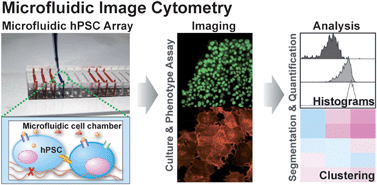Microfluidic image cytometry for quantitative single-cell profiling of human pluripotent stem cells in chemically defined conditions†
Abstract
Microfluidic image cytometry (MIC) has been developed to study phenotypes of various

* Corresponding authors
a
Department of Molecular & Medical Pharmacology, University of California, Los Angeles, CA, USA
E-mail:
kkamei@mednet.ucla.edu, hrtseng@mednet.ucla.edu
b Crump Institute for Molecular Imaging, David Geffen School of Medicine, University of California, Los Angeles, CA, USA
c California NanoSystems Institute, University of California, Los Angeles, CA, USA
d Institute for Molecular Medicine, University of California, Los Angeles, CA, USA
e Eli and Edythe Broad Center of Regenerative Medicine and Stem Cell Research, University of California, Los Angeles, CA, USA
f Department of Microbiology, Immunology and Molecular Genetics, University of California, Los Angeles, CA, USA
g Department of Biological Chemistry, University of California, Los Angeles, CA, USA
h Department of Molecular Cell and Developmental Biology, Los Angeles, CA, USA
i Department of Pathology and Laboratory Medicine, Los Angeles, CA, USA
j Department of Chemistry & Chemical Biology, Institute for Advanced Materials, Devices and Nanotechnology, Rutgers Stem Cell Research Center, Rutgers, The State University of New Jersey, Piscataway, NJ, USA
k Howard Hughes Medical Institute, David Geffen School of Medicine, University of California, Los Angeles, CA, USA
Microfluidic image cytometry (MIC) has been developed to study phenotypes of various

 Please wait while we load your content...
Something went wrong. Try again?
Please wait while we load your content...
Something went wrong. Try again?
K. Kamei, M. Ohashi, E. Gschweng, Q. Ho, J. Suh, J. Tang, Z. T. For Yu, A. T. Clark, A. D. Pyle, M. A. Teitell, Ki-Bum. Lee, O. N. Witte and H. Tseng, Lab Chip, 2010, 10, 1113 DOI: 10.1039/B922884E
To request permission to reproduce material from this article, please go to the Copyright Clearance Center request page.
If you are an author contributing to an RSC publication, you do not need to request permission provided correct acknowledgement is given.
If you are the author of this article, you do not need to request permission to reproduce figures and diagrams provided correct acknowledgement is given. If you want to reproduce the whole article in a third-party publication (excluding your thesis/dissertation for which permission is not required) please go to the Copyright Clearance Center request page.
Read more about how to correctly acknowledge RSC content.
 Fetching data from CrossRef.
Fetching data from CrossRef.
This may take some time to load.
Loading related content
